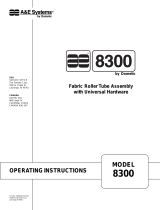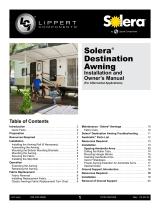Page is loading ...

1
USA
SERVICE OFFICE
The Dometic Corp.
509 So. Poplar St.
LaGrange, IN 46761
CANADA
Dometic Dist.
866 Langs Dr.
Cambridge, Ontario
CANADA N3H 2N7
For Service Center
Assistance Call:
800-544-4881
INSTALLATION
INSTRUCTIONS
MODEL
8270004 Series
Nested Hardware
This manual must be read and understood before in-
stallation, adjustment, service, or maintenance is per-
formed. This unit must be installed by a qualified ser-
vice technician. Modification of this product can be ex-
tremely hazardous and could result in personal injury
or property damage.
SUNCHASER
Fabric Roller Tube Assembly
Form No. 3109831.002 11/00
(French 3109833.008)
©2000 The Dometic Corporation
LaGrange, IN 46761
8270004 Series Nested Hardware
for use with
Important: This literature must stay with unit.
Owner read carefully

2
COVERED BY ONE OR MORE OF THE FOLLOWING
PATENTS: 4,524,791; 5,351,736; 5,351,827; 5,383,346;
5,472,007; 5,516,244; 5,566,918; D366,763; D395,170;
others pending
REQUIRED PARTS (Packed with each Hardware Assembly)
(2) Arm Caps
(2) 1/4–20 Machine Screws
(2) 1/4–20 Short Locknuts
(2) Nylon Washers
(4) #14 x 2 Screws
DO NOT REMOVE the NAIL from the right end at this
time and DO NOT attempt to rotate the Safe-T-LockTM
Direction Lever until installation is complete. (Lever
has been preset in the roll-down position.) (FIG. 2A,)
4. Prepare the awning rail to accept the awning roller
cover. Select the end from which the awning shall be
fed, then widen that end of the rail with a flat screw-
driver and file off any sharp edges. (FIG. 3)
5. With one person grasping each support arm, carefully
lift the entire assembly upright. Keep the two arm
assemblies Parallel to each other to avoid damage
due to twisting Carry the awning to the prepared
awning rail end. (FIG. 4A & B)
Feed the awning into the awning rail while standing on a
stepladder, (third person) while two carry the awning
assembly to the desired position.
Door roller kit #830304 is available from The Dometic
Corporation.
(4) #14 x 3 Screws
(2) #10 Machine Screws
(2) #10 Locknuts
(2) Stop Washers
(2) #6 Self-Drilling Screws
Application
The standard A&E awning is designed and intended for use
on motorhomes, mini-motorhomes, 5th wheels and travel
trailers with straight sides. For curved sides, please see the
separate Hardware List in the Dealer Service Manual for the
appropriate model.
IMPORTANT: Read and understand ALL of the follow-
ing steps before beginning installation.
The Dometic Corporation reserves the right to modify appear-
ances and specifications without notice. A&E Awnings can
be installed by one person with brief help from two others.
Use the following procedure to assure a properly installed,
and properly functioning awning.
1. When the awning is mounted above a square corner
entry door, a door roller and guard must be installed per
FIG. 1A and 1B to reduce the potential of damage to the
fabric. Rounded doors may not require a door roller if the
door will not damage the fabric.
2. Carefully lay the fabric roller tube assembly on a clean,
well padded "V" trough to prevent fabric damage. Working
on the torsion lock end first, insert the arm cap into the
arm, position the nail in the end cap to the front of the
hardware, align and secure the arm assembly to the
torsion rod using the 1/4–20 machine screws, nylon
washers, and 1/4" locknuts. (FIG. 2A) Align and attach
the other end.
3. Remove the left nail only. With both awning arms secured
to the Fabric Roller Tube Assembly, and facing the floor,
rotate the left arm clockwise as if rolling the fabric up. This
takes the torsion pressure off of the nail. Remove the nail
by hand and lower the arm to the floor. (FIG. 2B)
FIG. 2A
FIG. 2B
INSTALLATION
FIG. 1A
DOOR EDGE
GUARD
SCREEN
DOOR
FIG. 1B
Position Wheel
Directly over edge
of Door
ENTRY
DOOR
Wheel Above
Door 1/4" – 3/8"

3
BOTTOM
MOUNTING
BRACKET PATIO
FOOT
RELEASE LEVER
BOTTOM
MOUNTING
BRACKET PATIO
FOOT
RELEASE LEVER
FIG. 5A
Place top bracket in position over awning rail as shown in
FIG. 5B, and align bracket directly behind and centered with
the main support arm.
Lift the arm handle (releasing lock button) and CAREFULLY
extend the inner arm to the ground to support the awning.
Pull the main support arm away from the top bracket and
rafter arm. Mark the top bracket position and predrill the two
3/16" dia. holes ( 7/32" dia. in steel). Install top bracket with
two #14 hex. hd. screws (FIG. 5C). Seal where the screws
enter the coach with silicone.
Place main support arm over the extension portion of the top
bracket. (FIG. 5B).
Install remaining top bracket using the same procedure.
7. Install Bottom Brackets
Snap the patio foot on the bottom of the inner arm into the
bottom bracket. (FIGS. 6A & 6B). Insure the arm top casting
is resting on the top pivot. Lift the main arm handle and slide
the inner arm up to the desired mounting position. Select the
best supporting structure, i.e. mount directly into the floorline,
molding, etc. Close the travel latch.
Mark position of bottom bracket holes into the floorline. Pre-
drill two 3/16" dia. holes through the marked locations. (Drill
7/32" dia. into steel).
The inner arm is still temporarily resting over the top bracket.
Mark position of bottom bracket so that both holes are
positioned over the floorline. Disconnect bottom bracket from
patio foot and pre-drill two 3/16" dia. holes through the
marked locations. (Use 7/32" dia. if drilling through steel).
Secure the bottom bracket to the coach using two #14 hex
head screws. (FIG. 6C). Seal where the screws enter the
coach with clear silicone. Snap the foot back into the
bracket.
Repeat for other side.
Note: If installing over a molding,
A&E Standoff Kit 3104781
may be used (See Fig. 6D).
6. Install Top Brackets.
After the complete awning assembly has been slid into the
awning rail, check to be sure that its
position allows for solid mounting
of the top and bottom brackets and
that support arms are in desired loca-
tion (not restricting use of doors,
access doors, etc.). (FIG. 5A)
BEFORE
AFTER
FIG. 3 FIG. 4A
ARM
ASSEMBLY
AWNING
RAIL FABRIC ROLLER
TUBE ASSEMBLY
FIG. 4B
AWNING
RAIL
FABRIC
FIG. 5C
FIG. 5B
FIG. D
FIG. 6B
FIG. 6A
RELEASE LEVER
PATIO FOOT
BOTTOM
BRACKET
FIG. 6C
Apply Sealant
to Screw Threads
Bottom Mounting
Bracket
#14 Hex
Head Screws
MOLDING
STANDOFF
FIG. 6D
TOP
MOUNTING
BRACKET
MAIN
SUPPORT
ARM
AWNING RAIL AWNING RAIL
TOP MOUNTING
BRACKET
RAFTER
#14 Hex
Hd. Screw
MAIN ARM
ASSEMBLY
LIFT
HANDLE

4
10.Secure Awning to Rail
Open and close awning a few times to allow for natural self
adjustment of awning. Insure the arms are still positioned
directly in front of the top brackets.
The fabric will locate itself. Pull the fabric sideways 1/4" in the
awning rail. Measure in 2" from the edge of the fabric and
secure by driving a #6 self-drilling screw through the rail and
into the fabric rope. (FIG. 9)
Repeat at the other end, pulling the fabric 1/2" and holding
while securing the fabric. This will ensure a wrinkle-free
weather shield.
11. Operate awning according to the Operating Instructions
to check that all parts function properly.
12. Secure the travel latches and tighten the knobs.
8. Install Stop Plugs.
This step is essential for the proper function-
ing of all A&E Awnings.
Using the lift handle, RAISE THE MAIN ARM UP BY ONE
HOLE ONLY.
Install an aluminum stop washer on the inner arm side,
through the hole closest to the bottom of the main arm with
a #10 Phillips screw and a #10 lock nut (FIG. 7).
THE MAIN SUPPORT ARM SHOULD NOW CLEAR THE
TOP PIVOT WHEN THE AWNING CLOSES.
Repeat for other side.
9. Releasing Pre-Set Tension.
When removing nails, keep hands clear of hardware
and roller tube. Springs are under tension and the
awning will attempt to close.
The nail is found in the roller tube end cap (FIG. 8). Twist the
roller tube as if unrolling awning while pulling the nail by hand
and discard.
Remove wire tie from the Safe-T-Lock™ Lever. Rotate the
lever to the roll up position and allow the awning to roll up.
The awning should now roll up snugly against the vehicle
side. If no tension is felt, check to make sure the Safe-T-
LockTM Lever is in the roll-up position.
FIG. 7
MAIN ARM
ALUMINUM
STOP WASHER
#10 x 5/8"
PHILLIPS HD.
SCREW
INNER
ARM
3/16" DIA. HOLE
CLOSEST TO
MAIN ARM
#10 LOCK NUT
FIG. 8
FIG. 9
ROLLER TUBE
END CAP
Safe-T-Lock Lever in
Roll Up
Position
REMOVE
NAIL
/



